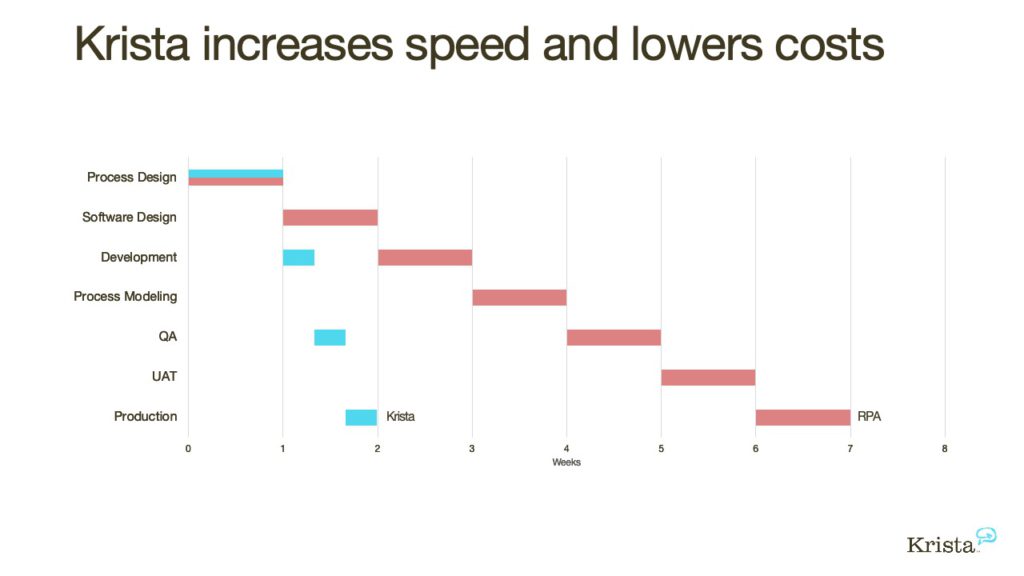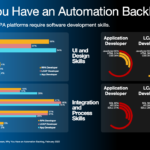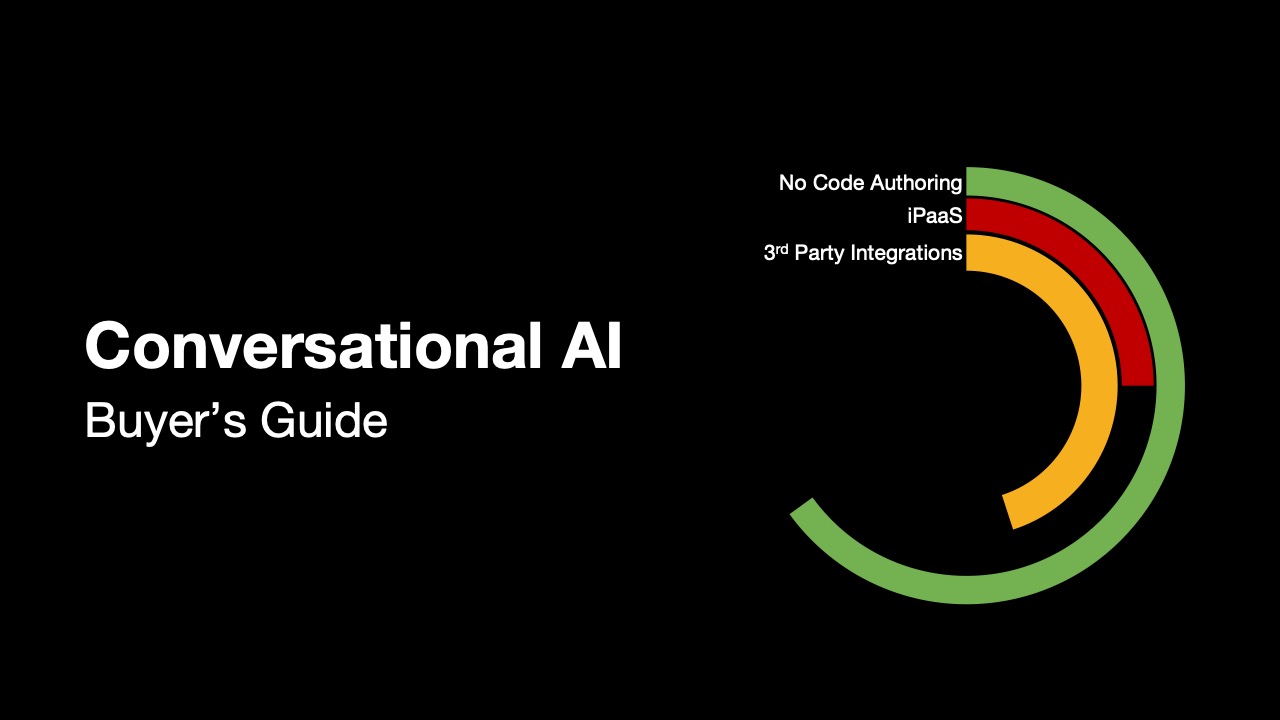Robotic process automation (RPA) is undoubtedly one of the most disruptive technologies in recent years, but what is the future of RPA? Enterprises all over the world have implemented RPA, bots, or digital workers to take stable rule-based processes from workers and hand them over to software. It has created billions of dollars of labor cost savings and value for highly manual, repetitive, and high-volume processes. McKinsey & Company reviewed 16 case studies1 and calculated anywhere from 30 to 200 percent return on RPA investments inside the first year. That’s a lot of value.
What does the future hold for RPA?
Despite providing high returns on investments, RPA projects frequently fail to meet business expectations. Many achieve early success with simple RPA projects and realize high returns. However, when leaders look into the future of RPA, they recognize that bot maintenance burdens and overhead increase costs over time.
A Forrester study found 99% of bots require custom scripting. According to the same report, these scripts lack resiliency and require very technical skills despite touted “citizen developer” capabilities. Firms that struggle with bot resiliency are 4x times more likely to be ineffective at controlling RPA program costs. Therefore, firms reach out to outside contractors for services to make up for technical skill deficits.
According to HFS Research2, for every dollar spent on RPA software licenses, four dollars are spent on services. The heavy maintenance requirements for scripts increase the total cost of ownership and create technical debt. In fact, according to a study by Ernst & Young, 30% to 50% of robotic process automation projects fail globally3. If you are using RPA, you may wonder what your total cost of ownership is and how to maintain a healthy cost structure in the future? 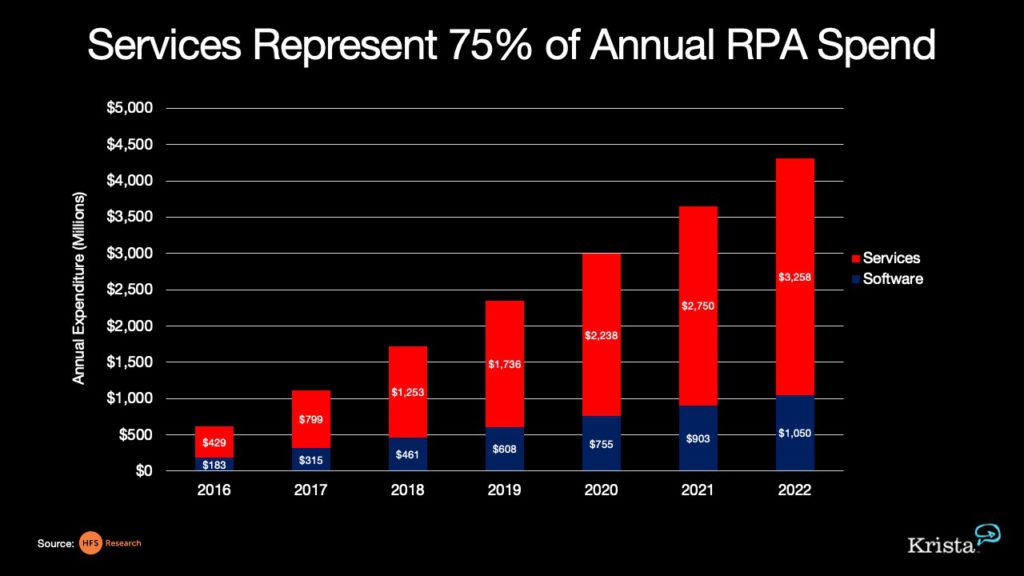
This article explores areas of consideration and how to plan for the future of RPA. I’ll speak to issues that cause RPA projects to stall, the challenges behind automating variable and unstable processes, how you can lower your cost of ownership, increase agility, and provide a path to maximizing artificial intelligence and machine learning.
RPA provides value but limits your transformation
Every technology has its pros and cons. RPA is no exception. While it is true that RPA bots save time when performing repetitive tasks, they also have severe limitations, which I review below.
Unattended bots require restarts and handholding
Unattended RPA bots promise that they work on their own, hence their name. In that sense, they are supposed to be ideal for end-to-end process automation. In theory, once the rules are programmed for a process, these bots work independently without requiring further human attention. However, in practice, few processes remain static. Any change in the process, no matter how small, will require a restart and/or adjustment in the bot’s programming.
In other words, these bots are good for automating back-office processes at scale since there are few changes in the processing logic. However, they do require attention when the inevitable happens, and the workflow is modified, a new tool is added to the value chain, the system is changed, or the task schedule changes.
UI is brittle and breaks bots
In the previous point, I mentioned how simple process/workflow changes could break an RPA bot. Unfortunately, these are not the only type of changes that can generate RPA issues. One of the biggest technical challenges in RPA has to do with the user interface (UI).
Suppose a new version of your Enterprise Resource Planning (ERP) is released. Generally, one thing to expect from new versions is revamped user interfaces that are more user-friendly and efficient. It is safe to assume that this type of change will cause problems with RPA since the placement of buttons and text boxes will most likely be in different places. This same situation will arise with any software that makes changes or updates its UI.
High development and maintenance costs
Automation solutions focused exclusively on RPA are complex to develop and implement, to the point that they end up requiring their own Software Development Life Cycle (SDLC). One of the most challenging aspects of process automation has to do with the maintenance of the scripts used in RPA bots because every change is a code change. Each change requires a programmer—no wonder the costs are high.
The overhead for small changes makes small agile changes very time-consuming. In part, this is due to the fact each change is a testable event. This means each change to a bot requires unit, integration, QA, and UAT approvals before it is redeployed. A tiny change takes months to deploy since it has to proceed through the entire SDLC.
Bots focus on task automation
Today, the trend is to harness the potential of artificial intelligence (AI) and machine learning (ML). If you wonder if the future of RPA can deliver, you are not alone. Since RPA is a technology aimed at automating tasks usually completed by humans, it’s hard to imagine how these task-based automations could process at hyper speed and leverage AI in the future. IDC forecasts worldwide revenues for the AI market, including software, hardware, and services, will grow 19.6%4 year over year in 2022 to $432.8 billion and break the $500 billion mark in 2023.
“AI has emerged as the next major wave of innovation,” explains Ritu Jyoti, group vice president, Worldwide Artificial Intelligence (AI) and Automation Research at IDC. “AI solutions are currently focused on business process problems and range from human augmentation to process improvement to planning and forecasting, empowering superior decisioning and outcomes. Advancements in language, voice and vision technologies, and multi-modal AI solutions are revolutionizing human efficiencies. Overall, AI plus human ingenuity is the differentiator for enterprises to scale and thrive in the era of compressed digital transformation.”
Adopting AI into your company is vital for its survival. You must realize that tasks automated at the human level will never be fast or structured enough to leverage AI successfully. Hence, the question arises as to whether the future of RPA platforms can deliver what you need. Maybe that step(s) are unnecessary. It is better to implement a more scalable and agile solution capable of completing hundreds of automations in the time it takes one bot to run.
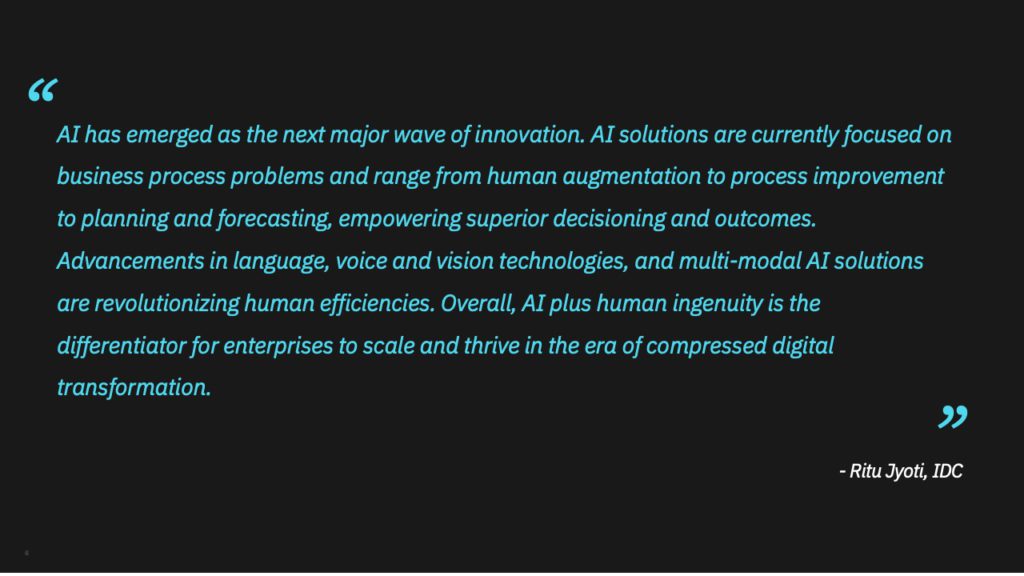
To hyper automate processes in the future, you need more than just RPA
To hyper-automate processes in your company in the future, you need to understand intelligent automation or hyperautomation, as Gartner calls it. But, before I get into specifics, I’ll explain the benefits of fully automating processes by exploring real-world use cases.
Automated weekly reports
Conventional Robotic Process Automation: A typical example consists of programming a robotic process automation task where the bot logs in to the ERP system and exports the data related to inventory levels as comma-separated values (CSV) files. Once this is done, the bot could add predefined columns to group the information and perform the relevant calculations.
The resulting spreadsheet can be saved to be emailed as an attachment or shared on a file server. The process is not complicated, yet it could take a person 10 minutes to complete from start to finish. Assuming 20 reports like this are needed per week, we would be talking about 200 minutes that RPA could save each week. Not bad.
Intelligent Automation: Let’s look at the same task but from intelligent automation (IA) perspective. The first thing the IA would do is to identify the purpose of the report, i.e., what is the desired business outcome? In this particular example, the goal is for a person to take a business action using the inventory information.
Based on that business outcome, the intelligent automation would calculate inventory levels and use AI to determine if those levels are normal, based on historical and seasonal patterns. Once completed, the IA would present the relevant information to the decision-maker and ask them what to do. The IA would place the corresponding order to maintain the appropriate inventory levels depending on the answer. In other words, the objective of IA is to keep items replenished, not the task of emailing a report.
Optimization of inventory levels
Now that you have a better understanding of intelligent automation’s potential, it is time to take the above example to the next level. Suppose your organization wants to maintain an optimal inventory of each product. This is a complex task that requires the involvement of different business units and accurate data on sales, inventory levels, production, orders in process, and more.
In this case, IA would be responsible for optimizing inventory levels to avoid being too high or too low. This would be based on historical patterns, seasonality, market trends, and supply chain response time, among other factors. These projections would be sent to sales operations and product analysts to decide accordingly, whether it be placing an order to replenish inventory or promoting an aging product.
Robotic process automation challenges
When I asked a group of experts to rank each aspect of automation according to its difficulty, leveraging AI and ML scored the highest. While there are many reasons, two stand out from the rest, fear of change on the part of employees and the challenges of implementing AI and ML.
AI helps people and doesn’t eliminate them
Contrary to what many people think, AI and ML were not created to eliminate human personnel but to help them make the most of their potential. On the one hand, AI helps organizations uncover valuable business insights that make them more resilient and agile. On the other hand, they help people automate tedious and repetitive processes so they can spend their time on creative work or problem-solving. The result is a win-win situation, where staff benefits from time savings and better organizational decisions that facilitate their daily work.
It’s challenging to operationalize AI and ML
Implementing AI and ML projects is a challenge because few cases yield the expected results. In fact, 85% of the projects fail. The question is, what causes such a high failure rate? Among the most common causes are:
Poor collaboration between the parties involved.
The success of any automation implementation depends to a large extent on the collaboration between the different business units. Simply put, this type of project often fails because of the culture of working in silos.
Inadequate data.
Data is the raw material that feeds every successful machine-learning project. For this reason, it is vital to prepare the data, reformat it, and eliminate any bias or abnormality that could harm the process.
Lack of a clear business objective.
It is impossible to expect good results if the problems to be solved are not clearly identified. In this sense, the best strategy is to have measurable business goals that are aligned with top-line initiatives.
Last-mile implementation.
Many automation initiatives fail in implementing the “last mile” phase, that is, in the delivery of the product or service to the end customer. The solution? Adopt a process-driven approach to align with customer goals and expectations throughout the organization.
Fortunately, Krista increases success rates significantly thanks to its innovative approach. Krista allows your team members to quickly operationalize ML by removing technical barriers and complexities from the equation and lowering the cost of implementing AI.
Intelligent Automation increases throughput by orchestrating people, apps, and AI
Intelligent process automation takes your rule-based RPA strategy to the next level by integrating artificial intelligence (AI), machine learning (ML), and natural language processing (NLP) into the mix. As a result, your organization will be able to create end-to-end automated workflows with unsurpassed adaptability and flexibility in record time. Krista makes all of this possible by creating and modifying rules on the go based on what it learns from the manual actions executed by your employees. Put another way, Krista orchestrates people, applications, and AI for maximum performance.
Krista
Throughout this article, I have talked a lot about intelligent automation, and how it benefits automation initiatives, so you may be wondering, what is Krista? And more importantly, how can she help automate entire processes from start to finish? In this section, I will take a quick tour of the unique benefits Krista brings to your business.
Krista is Intelligent Automation
Krista is an intelligent automation platform that enables your company to orchestrate end-to-end business processes across your people, applications, and AI. Krista provides an easy way to implement AI in your company at significantly lower costs and removes the complexity associated with interacting with disparate apps.
As you automate processes with Krista, she automatically uses ML to structure your data easily and intuitively. In other words, thanks to the synergy between ML and AI, Krista can learn from your decisions and gradually improve processes. Rediscover the power of automation and put aside your fears regarding AI with Krista.
Automates End-to-End Business Outcomes
While RPA focuses on automating trivial tasks that are usually isolated from the rest, Krista is designed to automate business outcomes. What does this mean? When you deploy Krista’s AI/ML, it can make autonomous decisions that take full advantage of your existing task automation. Moreover, since Krista is built to optimize end-to-end business outcomes, she will make constant changes to meet those objectives. The result of digitizing processes in this way will significantly impact increasing efficiency, both at a low level and at an organization-wide level.
Changes Take Minutes Instead of Months
Unlike most automation platforms, Krista allows any member of your team to create and modify automation, even if they have no programming skills. This makes a huge difference since the organization saves time and money, but most importantly, it allows the process stakeholders to design and manage the automation they need. As a result, your organization will be able to adapt quickly and efficiently to changes without having to pay a fortune and wait for the automation to be ready.
Strong, Secure, and Flexible
All of Krista’s advantages would be of little use if it were not able to offer the security, flexibility, and resiliency you expect from an enterprise-level app. Fortunately, Krista is all that and more. Krista is designed from the ground up to distribute workloads, be highly scalable, and offer event-driven automation like no other platform.
Furthermore, Krista is fast, easy to program, deploys in minutes, and supports a wide range of clients and operating systems on both desktop and mobile. As you would expect from an enterprise-ready application, Krista also provides you with a robust API with which you can automate any process, in any app, and from anywhere.
Key to Digital Transformation
Your organization’s path to digital transformation doesn’t have to be overwhelming. Krista provides a method for digital transformation in your organization with Krista’s user-friendly and flexible technology. Krista’s intelligent automation allows you to focus on improving business outcomes simply and establish a digital culture. With no programming skills, your team can leverage the power of Krista to automate and optimize your processes like never before using a conversational format they are already comfortable with.
Improving your digital future
This article has explored the challenges and limitations of robotic process automation and the main reasons why RPA may not carry you into the future. At the same time, it has introduced what, in my opinion, is the future of automation, Intelligent Automation. Krista’s ease of deployment, innovative conversational interface, and her ability to adapt to humans (and not the other way around) will allow your business to enjoy the benefits of AI/ML and achieve its goals.
Sources:
